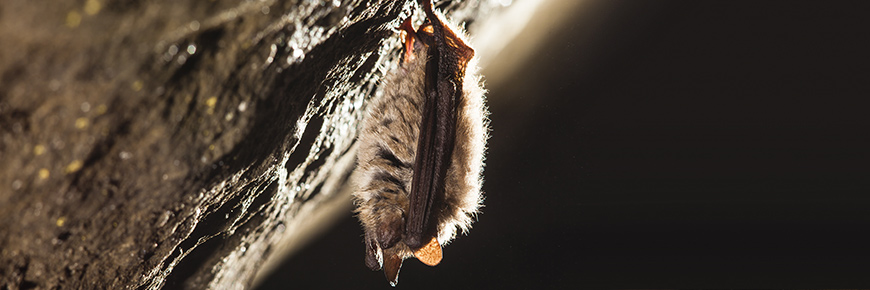
Bat monitoring
Kouchibouguac National Park
Little brown bat (Myotis lucifugus)
Northern long-eared bat (Myotis septentrionalis)
Tricoloured bat (Perimyotis subflavus)
In Mi’gmaq (bat): Na’jipugtaq’nej
SARA Status: Endangered
Bats are primarily nocturnal animals belonging to the taxonomic group Chiroptera (chiro: “hand”, ptera: “wing”). In many ways, they are typical mammals: they are warm-blooded, give birth to live young and produce milk. Their ability to fly, however, sets them well apart from all other mammal groups.
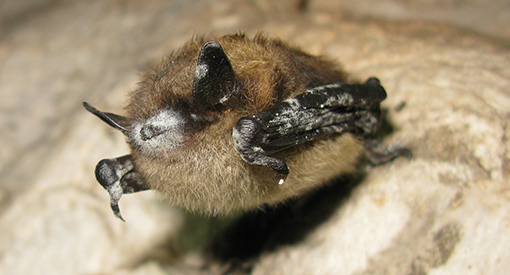
Through evolution, these fascinating animals have developed an acute sense of hearing to supplement their night vision; this explains why they have such large ears in comparison to their tiny head. In conjunction with their sensitive hearing, bats have also developed the ability to emit short high-pitched clicking sounds (ultrasounds inaudible to the human ear) which bounce off objects like an echo, guiding them to avoid obstacles and predators or catch prey during flight. This ability is called echolocation.
One of the foremost threats facing hibernating bats in North America is a fungal infection known as White-Nose Syndrome (WNS). The disease is characterized by white fungal growth on muzzles, ears, and/or wing membranes of affected bats. It causes individuals to awaken during winter months when they should be deep in hibernation; infected individuals commonly starve and freeze to death as a result. The fungus responsible for WNS is widely believed to have been introduced from Europe, where it likely originated (European bats are much less susceptible to it and are therefore believed to have co-evolved with the disease).
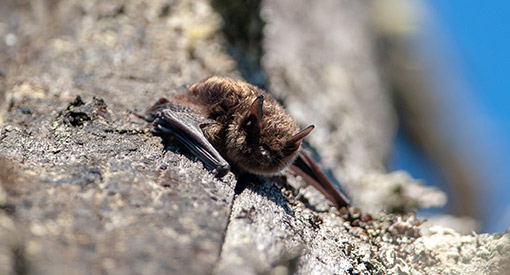
In North America, WNS was first discovered in the state of New York in 2006 and has spread rapidly over the last decade and a half throughout much of the continent, likely aided by human activity. It was first detected in Canada in 2009 and has been present in New Brunswick since 2011. Within two years of becoming established at hibernation sites (called hibernacula), the disease has been shown to bring about severe mortality in some bat species (particularly cave-hibernating species), resulting in population declines of 75-95%. In response to the rapid spread of WNS and drastic declines in some bat species, emergency status assessments were conducted by the Committee on the Status of Endangered Wildlife in Canada (COSEWIC) in 2013, resulting in the addition of three bat species to the federal Species at Risk Act (SARA).
Kouchibouguac National Park is home to seven different bat species, three of which are especially sensitive to WNS and have been designated as endangered under the federal Species at Risk Act (SARA). Although the park doesn’t contain wintering sites for these cave-hibernating species, it holds ample summer habitat and an abundant food supply. The Little Brown Myotis, as its name suggests, is a small brown bat with darker ears, wings and tail. The Northern Long-eared Myotis looks quite similar in terms of size and colour, but can be distinguished by the size of its ears, which are roughly twice the size of the Little Brown Myotis’s ears. The Tri-coloured Bat is the smallest of our three protected species, typically weighing only 5 to 8 grams (about as heavy as a loonie!). At a distance, its fur has a yellowish to greyish-brown colour. The species’ common name refers to its three-coloured hairs, which upon closer inspection show distinct bands along their length (a dark base, lighter brown middle and yellowish-brown tip).
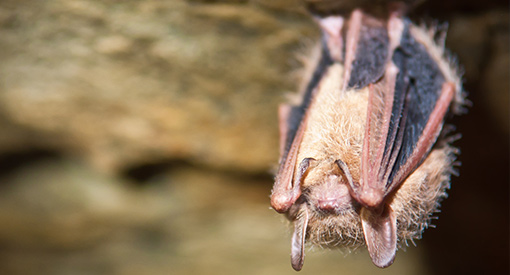
In addition to WNS, our protected bat species are also threatened by loss of habitat, large-scale insecticide use and wind turbines. Sadly, colonies established in buildings are still commonly considered a nuisance and are sometimes intentionally or accidentally eradicated.
Life cycle
- Spring – Gestation
In the springtime, female bats leave the males behind in their hibernacula and congregate in maternity colonies inside buildings or large-diameter trees. The gestation period may vary between 44 and 60 days, depending on the species. Huddling together encourages a more rapid growth of the embryo. - Summer – Raising young ones
Bats usually give birth to a single pup, sometimes two in the case of the tri-coloured bat. Thanks to the rich maternal milk, the rapidly growing pups are weaned shortly after one month. Even after reaching their adult size, the pups will remain with their mother until the end of the summer, learning to fly, to hunt and to locate roosts. - Fall – Mating and Migration
All three of our protected species congregate in massive numbers in caves or mines during autumn in order to mate and reproduce before ensuring successful hibernation. Most bat species will return to the same roosting sites year after year. - Winter – Hibernation
In winter, all three species often congregate and hibernate together in cold and humid areas in caves or mines (called “hibernacula”). During hibernation, bats survive by using the stored fat reserves accumulated in the summer and fall months. By decreasing and maintaining their body heat to the ambient temperature of their surroundings (oscillating between 3°C and 6°C), bats can reduce their metabolism rate by 96%!
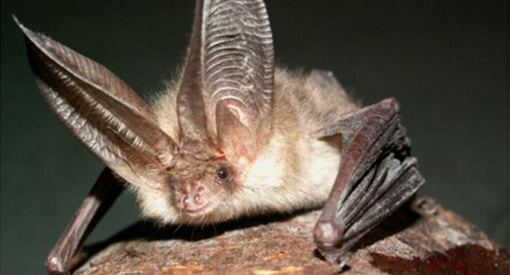
In 2015 and 2016, the park’s Resource Conservation team deployed acoustic recorders capable of recording ultrasounds emitted by bats at a total of 34 sites within the park. Survey sites were purposefully scattered to capture various habitats in different geographic areas within the park, including both front country and more remote areas. Staff recently analyzed each recorded bat call to identify the species emitting them. Our results provide evidence for the presence of seven species in the area. Most notably, the project provided the first documentation of the Endangered Tri-coloured Bat in Kouchibouguac National Park. By comparing with the results of previous studies conducted prior to the arrival of WNS in the region, recently collected data will help identify trends in distribution and abundance.
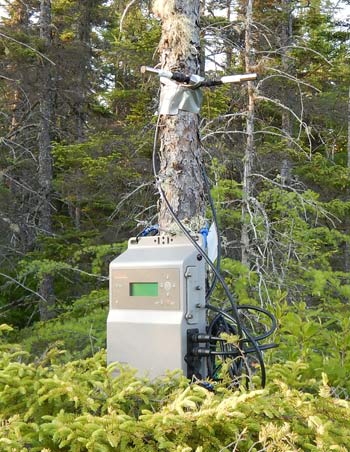
Kouchibouguac National Park has also adopted a series of best practices applicable to all current building inspections, helping employees in detecting bat presence or potential roosting sites. In addition, prior to any new renovation or construction project, the park must ensure that all guidelines of the Dark Sky Preserve are respected, thus limiting potential light pollution and benefiting nocturnal wildlife.
Fun facts
- Bats are among the main natural predators of flying insects and they can devour more than 50% of their total body weight in moths, beetles and mosquitoes in one night! They’re also the only mammals capable of true flight thanks to their “winged hands”!
- Bat moms sometimes fly with their newborn pups. The young one clings to its mother’s underarm nipple by the mouth and hangs onto her waist with its toes. Hold on tight little one!
Listen to the bat
Echolocation recording of a bat (slowed x2)
More information
Download the brochure BATS: A closer look at our species at risk as a PDF (7 MB)
- Date modified :